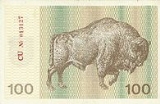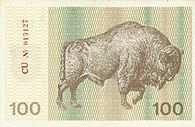
Lithuanian talonas
Encyclopedia

Lithuania
Lithuania , officially the Republic of Lithuania is a country in Northern Europe, the biggest of the three Baltic states. It is situated along the southeastern shore of the Baltic Sea, whereby to the west lie Sweden and Denmark...
between 1991 and 1993. It replaced the Soviet ruble
Soviet ruble
The Soviet ruble or rouble was the currency of the Soviet Union. One ruble is divided into 100 kopeks, ....
at par and was replaced by the litas
Lithuanian litas
The Lithuanian litas is the currency of Lithuania. It is divided into 100 centų...
at a rate of 100 talonas = 1 litas. The talonas was only issued as paper money.
The first talonas reform
| Year | Inflation rate (%) | |
|---|---|---|
| In Lithuania | In Russia | |
| 1991 | 225 | N/A |
| 1992 | 1100 | 2508.8 |
| 1993 | 409 | 849.9 |
| 1994 | 45.1 | 215.1 |
| 1995 | 35.7 | 175.0 |
| 1996 | 13.1 | 21.8 |
| 1997 | 8.4 | 11.0 |
| 1998 | 2.4 | 84.4 |
| 1999 | 1.5 | 36.5 |
| Sources http://countrystudies.us/lithuania/15.htm, http://www.fe.doe.gov/international/CentralEastern%20Europe/lithover.html, http://jec.senate.gov/_files/RussiaEconomy.pdf | ||
In early August 1991, as a response to public complaints about inflation
Inflation
In economics, inflation is a rise in the general level of prices of goods and services in an economy over a period of time.When the general price level rises, each unit of currency buys fewer goods and services. Consequently, inflation also reflects an erosion in the purchasing power of money – a...
, the Lithuanian government introduced the talonas (Lithuanian plural form is “talonai”; sometimes translated as “coupon”). It was a quick and unforeseen reform pushed by the Prime Minister Gediminas Vagnorius
Gediminas Vagnorius
Gediminas Vagnorius is a Lithuanian politician and signatory of the Act of the Re-Establishment of the State of Lithuania. He served as the Prime Minister of Lithuania between 1991 and 1992, and again from 1996 until 1999....
. At first, it was very similar to ration
Rationing
Rationing is the controlled distribution of scarce resources, goods, or services. Rationing controls the size of the ration, one's allotted portion of the resources being distributed on a particular day or at a particular time.- In economics :...
coupons: every person received 20% of his/her salary in talonas up to a maximum of 200 talonas. In order to buy goods other than food, a person had to pay the price in rubles and again in talonas (for example, if a pair of shoes cost 50 rubles, a person had to pay 50 rubles and 50 talonas to buy them).
This system was widely criticized. First of all, in no way it addressed the reasons why there were shortages of goods, i.e. it did not promote the supply
Supply (economics)
In economics, supply is the amount of some product producers are willing and able to sell at a given price all other factors being held constant. Usually, supply is plotted as a supply curve showing the relationship of price to the amount of product businesses are willing to sell.In economics the...
; it just limited the demand
Demand (economics)
In economics, demand is the desire to own anything, the ability to pay for it, and the willingness to pay . The term demand signifies the ability or the willingness to buy a particular commodity at a given point of time....
. Also, the demand for expensive goods (like home appliances) dropped sharply because people needed a lot of time to accumulate the necessary amount of talonas to buy them. It caused bottlenecks in the supply chain
Supply chain
A supply chain is a system of organizations, people, technology, activities, information and resources involved in moving a product or service from supplier to customer. Supply chain activities transform natural resources, raw materials and components into a finished product that is delivered to...
and further damaged already troubled production. In addition, this scheme could not prevent the hyperinflation
Hyperinflation
In economics, hyperinflation is inflation that is very high or out of control. While the real values of the specific economic items generally stay the same in terms of relatively stable foreign currencies, in hyperinflationary conditions the general price level within a specific economy increases...
of the ruble because the talonas was not an independent currency; it was a supplementary currency with a fixed exchange rate to the ruble. The system tried to encourage Lithuanians to save 80% of their salaries. But people accumulated their rubles and had nowhere to spend them. It led to the inflation of goods that did not require the talonas (like food or goods on the black market).

The second talonas reform
In the summer of 1992, everybody anticipated that the talonas would shortly be replaced by a permanent currency, the litasLithuanian litas
The Lithuanian litas is the currency of Lithuania. It is divided into 100 centų...
. Lithuania was desperately lacking cash (some workers were paid in goods rather than in cash) as Russia
Russia
Russia or , officially known as both Russia and the Russian Federation , is a country in northern Eurasia. It is a federal semi-presidential republic, comprising 83 federal subjects...
tightened its monetary policy. In addition, the litas coins and banknotes were already produced and shipped to Lithuania from abroad. However, on May 1, 1992 it was decided to reintroduce the talonas as an independent, temporary currency to circulate alongside the ruble in hopes to deal with inflation. A dual currency system was created. On October 1, 1992 the ruble was completely abandoned and replaced by the talonas. Lithuania was the last of the Baltic states to abandon the ruble. The self-imposed deadlines to introduce the litas were continuously postponed without clear explanations.
Nicknamed "Vagnorkės" or "Vagnoriukai" after Gediminas Vagnorius
Gediminas Vagnorius
Gediminas Vagnorius is a Lithuanian politician and signatory of the Act of the Re-Establishment of the State of Lithuania. He served as the Prime Minister of Lithuania between 1991 and 1992, and again from 1996 until 1999....
or "zoo tickets" after various animals native to Lithuania featured on the notes, the talonas did not gain public trust or respect. The banknotes were small and printed on low quality paper. People were reluctant to use them. Nevertheless, the talonas served its purpose: inflation at the time was greater in Russia than in Lithuania. Inflation in 1992 rose steadily due to an energy price spike after Russia increased oil and gasoline prices to world levels and demanded to be paid in hard currency
Hard currency
Hard currency , in economics, refers to a globally traded currency that is expected to serve as a reliable and stable store of value...
.
On June 25, 1993, the litas was introduced at the rate of 1 litas = 100 talonas. Worthless talonas were recycled into toilet paper
Toilet paper
Toilet paper is a soft paper product used to maintain personal hygiene after human defecation or urination. However, it can also be used for other purposes such as blowing one's nose when one has a cold or absorbing common spills around the house, although paper towels are more used for the latter...
in the Grigiškės paper factory
Grigiškes (company)
AB Grigiškės is the biggest manufacturer of sanitary-huosehold paper in the Baltic countries. The company is a manufacturer of toilet paper, paper towels and napkins, corrugated cardboard and cartons, hardboard and painted hardboard. AB Grigiškės employs about 800 staff members...
.

